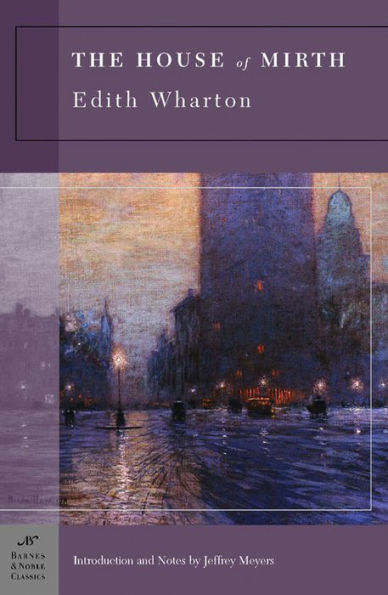The House of Mirth, by Edith Wharton, is part of the Barnes & Noble Classics series, which offers quality editions at affordable prices to the student and the general reader, including new scholarship, thoughtful design, and pages of carefully crafted extras. Here are some of the remarkable features of Barnes & Noble Classics:
Edith Wharton’s dark view of society, the somber economics of marriage, and the powerlessness of the unwedded woman in the 1870s emerge dramatically in the tragic novel The House of Mirth. Faced with an array of wealthy suitors, New York socialite Lily Bart falls in love with lawyer Lawrence Selden, whose lack of money spoils their chances for happiness together. Dubious business deals and accusations of liaisons with a married man diminish Lily’s social status, and as she makes one bad choice after another, she learns how venal and brutally unforgiving the upper crust of New York can be.
One of America’s finest novels of manners, The House of Mirth is a beautifully written and ultimately tragic account of the human capacity for cruelty.
Jeffrey Meyers, a Fellow of the Royal Society of Literature, has published forty-three books, including biographies of Ernest Hemingway, Edmund Wilson, Robert Frost, D. H. Lawrence, Joseph Conrad, and George Orwell.
The House of Mirth, by Edith Wharton, is part of the Barnes & Noble Classics series, which offers quality editions at affordable prices to the student and the general reader, including new scholarship, thoughtful design, and pages of carefully crafted extras. Here are some of the remarkable features of Barnes & Noble Classics:
Edith Wharton’s dark view of society, the somber economics of marriage, and the powerlessness of the unwedded woman in the 1870s emerge dramatically in the tragic novel The House of Mirth. Faced with an array of wealthy suitors, New York socialite Lily Bart falls in love with lawyer Lawrence Selden, whose lack of money spoils their chances for happiness together. Dubious business deals and accusations of liaisons with a married man diminish Lily’s social status, and as she makes one bad choice after another, she learns how venal and brutally unforgiving the upper crust of New York can be.
One of America’s finest novels of manners, The House of Mirth is a beautifully written and ultimately tragic account of the human capacity for cruelty.
Jeffrey Meyers, a Fellow of the Royal Society of Literature, has published forty-three books, including biographies of Ernest Hemingway, Edmund Wilson, Robert Frost, D. H. Lawrence, Joseph Conrad, and George Orwell.

House of Mirth (Barnes & Noble Classics Series)
400
House of Mirth (Barnes & Noble Classics Series)
400Related collections and offers

Product Details
| ISBN-13: | 9781593081539 |
|---|---|
| Publisher: | Barnes & Noble |
| Publication date: | 09/01/2004 |
| Series: | Barnes & Noble Classics Series |
| Pages: | 400 |
| Sales rank: | 22,908 |
| Product dimensions: | 7.96(w) x 5.32(h) x 1.05(d) |
About the Author

Customer Reviews
Explore More Items
At first glance, Three Lives seems to be three straightforward portraits of women living in the early twentieth century. “The Good Anna” describes an exacting German house servant;
Edith Wharton's Pulitzer Prize-winning novel was originally published in 1920. Set in gaslit 1870s New York, where society people "dread scandal more than disease," Newland Archer is deeply
Set in the 1870s, the same period as Wharton's The Age of Innocence, The Buccaneers is about five wealthy American girls denied entry into New York Society because their parents' money is too new. At
Tragic story of wasted lives, set against a bleak New England background. A poverty-stricken New England farmer, his ailing wife and a youthful housekeeper are drawn relentlessly into a deep-rooted
Originally born in an impoverished community, Charity's parents sought out the most educated man in the nearby New England town to raise their daughter. After being surrendered to a lawyer named
Nikolai Gogol’s novel Dead Souls and play The Government Inspector revolutionized Russian literature and continue to entertain generations of readers around the world. Yet Gogol’s
